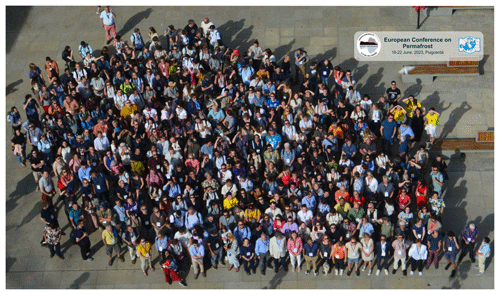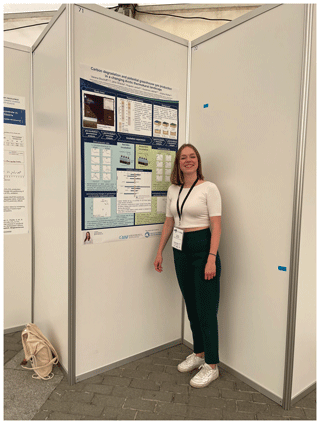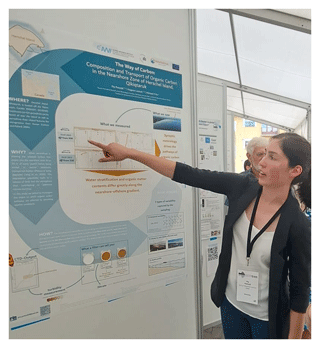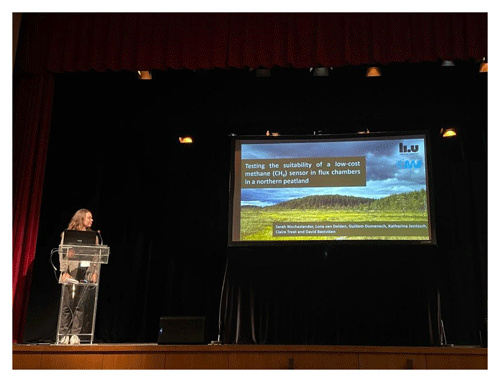Early-career researchers at the 6th European Conference on Permafrost
Verena Bischoff
Pia Petzold
Katharina Schwarzkopf
Sarah Wocheslander
The 6th European Conference on Permafrost (EUCOP), hosted by the International Permafrost Association (IPA), brought together researchers from all over the world in Puigcerdà, Spain, on 18–22 June 2023. The conference covered relevant aspects of permafrost research, from analysing and modelling the highly dynamic permafrost environment to the assessment of climatic and societal impacts. Approaches and methods were discussed during 3 intensive days of oral presentations and poster sessions, topped with local field trips across the eastern Pyrenees. For the recipients of funding by the German Society for Polar Research (DGP), EUCOP 2023 served as a platform for them to present their research to the international permafrost community, gain insights into current research trends, and establish valuable connections within the field.
- Article
(3729 KB) - Full-text XML
- BibTeX
- EndNote
The 6th European Conference on Permafrost (EUCOP) took place in Puigcerdà, Spain, from 18–22 June 2023. This was the first in-person permafrost conference by the International Permafrost Association (IPA) since 2018, due to the COVID-19 pandemic. The local organising committee was led by the Spanish IPA division, primarily by the Universitat de Barcelona (University of Barcelona). The overall theme of the conference was advances in permafrost research, engineering and outreach. More than 500 abstracts were submitted to the 24 scientific sessions, and about 450 participants attended the conference in the end (Fig. 1). The attendees came from Europe, North America, and Asia, representing a wide range of members of the permafrost community. They represented a variety of backgrounds and career stages, ranging from professors and established researchers to a large group of early-career researchers. The conference included an icebreaker event on Sunday (18 June), 3 d of scientific sessions which were kicked off by three keynote presentations, and a field excursion day. The sessions were split into communication blocks, with 4–6 presentations and poster sessions at the end of the day. There were always four communication blocks in parallel, which presented the challenge of having to decide which session to attend. To gain a complete overview of the conference, please follow the link to EUCOP's web page, where you find the abstracts of all presentations (https://eucop2023.com/, last access: 26 September 2023).

Figure 1Group photo of the participants of the 6th EUCOP in Puigcerdá, Spain. Photo source: https://eucop2023.com/ (last access: 26 September 2023).
The EUCOP programme encompassed a wide range of activities. Attendees were treated to a mix of meetings, workshops, scientific sessions, field excursions, and social events. Especially notable was the prominent presence of early-career researchers (ECRs), who made numerous scientific contributions. Many ECRs, including members of the Permafrost Young Researchers Network (PYRN), presented their work through both oral and poster presentations, emphasising the inclusion of ECRs within the permafrost research community. The PYRN workshop provided a platform to network, share insights, and demonstrate the value of their contributions to the wider research community.
The choice of Puigcerdá as the conference venue added a unique charm to the event. As a small town, it offered the advantage of short distances between venues, thus allowing participants to encounter each other easily on the streets and in the squares. This created an environment conducive to spontaneous networking and fruitful interactions while on the go. The intimate setting facilitated meaningful connections among researchers, fostering collaborations and the exchange of ideas.
A key moment during the conference was the round-table discussion on the future of permafrost research. This session brought together leading experts in the field to explore emerging trends and challenges. The insightful discussions and exchange of perspectives enriched the collective understanding of permafrost science and inspired collaborative efforts to address its pressing issues. In addition to the scientific sessions, participants were able to take part in various excursions in the Pyrenees and Andorra, focusing on periglacial landscapes. These excursions offered an opportunity to explore the geographical features of the eastern Pyrenees and to network further in a relaxed setting, thereby enriching the overall experience.
The German Society for Polar Research (Deutsche Gesellschaft für Polarforschung, DGP) supported five early-career researchers from the Alfred Wegener Institute, Helmholtz Centre for Polar and Marine Research, to attend the EUCOP in Puigcerdá. In the following, we briefly describe the individual scientific contributions to the conference.
Verena Bischoff contributed her poster entitled “Carbon degradation and potential greenhouse gas production in a changing Arctic thermokarst landscape” to session 19 (“Carbon stocks, soil properties, greenhouse gas fluxes, and atmospheric feedbacks of permafrost regions”; Fig. 2). The poster, which included preliminary conclusions derived from her masters' thesis, provided insights into carbon dynamics in drained lake basin sediments from the Yukon coastal plain in Canada. The greenhouse gas production potential of the heterogeneous sediment cores was evaluated in laboratory incubation experiments under both aerobic and anaerobic conditions, representing scenarios of dry and water-logged conditions at the drained lake sites. Her work further incorporates how the carbon decomposition is reflected in geochemical parameters such as carbon and nitrogen contents, isotopic signatures, and biomarker indices (ACL and CPI).

Figure 2Verena Bischoff in front of her poster on “Carbon degradation and potential greenhouse gas production in a changing Arctic thermokarst landscape”.

Figure 3Pia Petzold explaining her poster on “Composition and Transport of Organic Carbon in the Nearshore Zone of Herschel Island, Qikiqtaruk”.
Pia Petzold presented the preliminary results of her master thesis project on “Composition and Transport of Organic Carbon in the Nearshore Zone of Herschel Island, Qikiqtaruk” (Fig. 3). The poster presentation was in session 3, which covered “Permafrost land–ocean interactions: fluxes, transport processes, and degradation pathways”. Pia Petzold's research is focused on the sampling of two transects in the nearshore zone of Qikiqtaruk (formerly Herschel Island) during the field campaign in 2022. Samples were analysed for dissolved organic carbon (DOC) and particulate organic carbon (POC), as well as other parameters such as turbidity, temperature, and salinity. The results shown at EUCOP 2023 focused on the spatial and temporal variability over the recurring sampling of the transects over a period of 2 weeks and how wind directions influence the organic carbon content in the nearshore zone. Pia Petzold won the PYRN poster award for her poster presentation.
Alexandra Runge presented her European Space Agency's (ESA) Climate Change Initiative (CCI) fellowship work on “Identifying linkages between EO-based surface variables and permafrost temperature changes”. This was an oral presentation in session 24 (“Permafrost temperature changes and active layer dynamics: from local observations to global assessments of the permafrost system”). Alexandra Runge showed the use of multiple Earth observation (EO) datasets that describe surface variables, their changes and trends in the last 20 years, and the impact they have on the thermal state of permafrost. Additionally, this work presented the use of in situ permafrost temperature observations and their comparison to EO-based permafrost temperature trends.
Katharina Schwarzkopf presented her masters' thesis on “Organic matter distribution and origin in marine surface sediments on the Canadian Beaufort Shelf” (Fig. 4). The talk was given in session 3, which dealt with “Permafrost land–ocean interactions: fluxes, transport processes, and degradation pathways”. Katharina Schwarzkopf presented the Permafrost Carbon in the Beaufort Sea (PeCaBeau) expedition in 2021, which included sediment coring in five transects in the Canadian Beaufort Sea to investigate the concentration and distribution of organic carbon, nitrogen, mercury, and grain size in marine surface sediments. In addition, radiocarbon dating and stable isotope analyses were used to determine the sources and degradation status of terrigenous organic matter. The presentation highlighted the strong influence of bathymetry, currents, and distance to the Mackenzie River delta on the spatial distribution patterns and the degradation of organic matter.

Figure 4Katharina Schwarzkopf presenting her thesis on “Organic matter distribution and origin in marine surface sediments on the Canadian Beaufort Shelf”.
Sarah Wocheslander presented her masters' thesis project on “Testing the suitability of a low-cost methane (CH4) sensor in flux chambers in a northern peatland” (Fig. 5). The oral presentation was given in session 19 (“Carbon stocks, soil properties, greenhouse gas fluxes, and atmospheric feedbacks of permafrost regions”). Sarah Wocheslander tested the low-cost sensor in automated and manual flux chamber applications in a peatland in southern Finland in summer and autumn 2022. This work showed the potential of using low-cost technology for measuring greenhouse gas fluxes in wetlands and the implications for the calibration of the sensor. Different calibration curves, including multiple variables, were tested, and the importance of diel-specific, in situ sensor calibration, and issues for further research were presented.

Figure 5Sarah Wocheslander presenting her thesis on “Testing the suitability of a low-cost methane (CH4) sensor in flux chambers in a northern peatland”.
These brief summaries show the variety of scientific contributions made by the DGP fund recipients to the conference.
For most of us, EUCOP 2023 was our first international and first permafrost conference and therefore the first opportunity to present our research to the international permafrost community. The exchange with international scientists allowed us to get an overview of current permafrost topics and new ideas and perspectives regarding our own research. Equally important was the opportunity to meet new people and to start building our own network in the permafrost community.
Publisher's note: Copernicus Publications remains neutral with regard to jurisdictional claims in published maps and institutional affiliations.
We would like to express our gratitude to the DGP and PYRN for their funding, which made the attendance of EUCOP 2023 possible. Their financial support enabled us to participate in this scientific event and contribute to the advancement of permafrost research. We would also like to extend our appreciation to the local organising committee for their dedicated efforts in organising a successful conference in Puigcerdá. Last, we would like to acknowledge the International Permafrost Association (IPA) for their valuable contributions to the field of permafrost research, for their continued support of conferences like EUCOP, and for their inclusion of ECRs.





